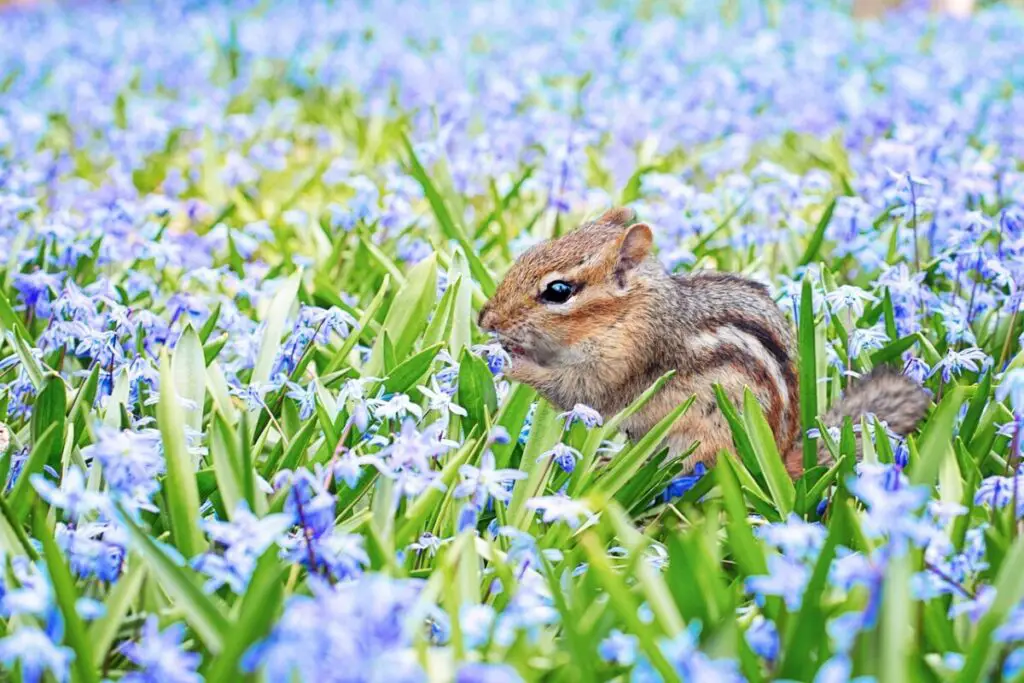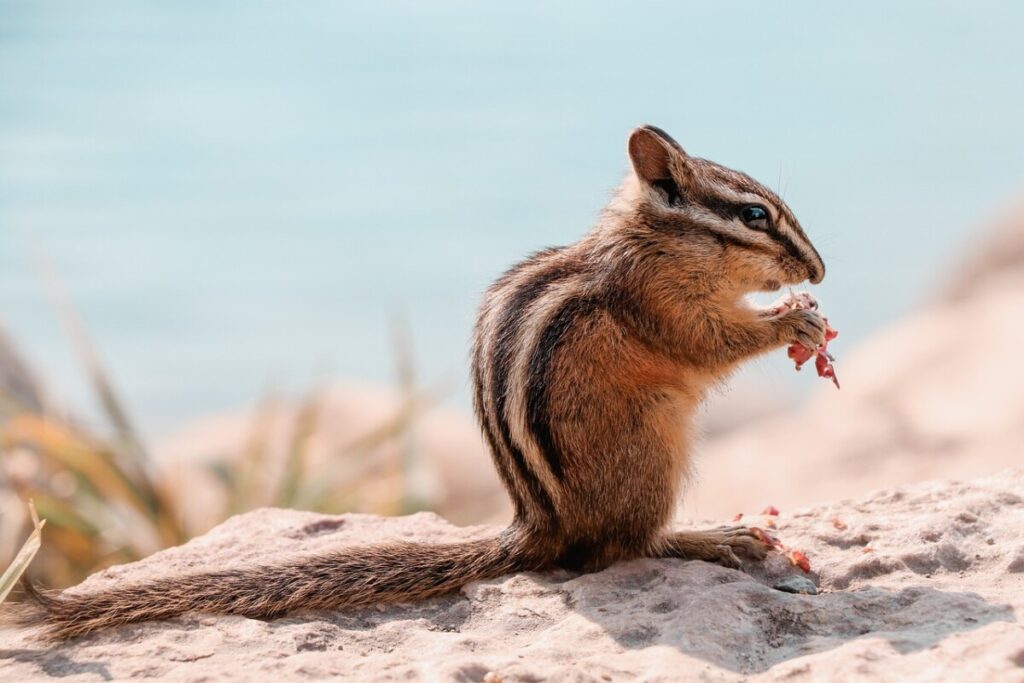Chipmunks are small rodents native to North America, Europe and Asia. They belong to the Sciuridae family, which also includes squirrels and prairie dogs. These animals are known for their distinctive stripes, large eyes and cheek pouches used for storing food. Chipmunks are omnivorous creatures that feed on a variety of plant matter as well as insects, larvae and eggs.
While chipmunks may be found in diverse habitats ranging from fields to forests, they have adapted to human-populated areas such as suburban yards and parks. These adaptable rodents can even become semi-domesticated when handfed by humans. Some species of chipmunk have been documented living up to six years in captivity; however, studies suggest wild individuals live much shorter lives due to predation and disease pressure.
The behavior of these fascinating little mammals is complex with different species exhibiting distinct behaviors such as nesting habits or mating rituals. In addition, recent research suggests some species use vocalizations similar to birdsong while communicating amongst themselves during social interactions. This article will explore the many features that make chipmunks so charming and beloved by people around the world.

Types Of Chipmunks
Chipmunks are small, ground-dwelling rodents that belong to the family of Sciuridae. They are known for their stripes and cheek pouches which they use to store food. These animals typically measure between 6–9 inches in length, including the tail, and weigh about 2 ounces. Chipmunks inhabit various habitats across North America, Europe, Asia and Africa.
There are 25 different species of chipmunks in existence today with three major groups: Eastern chipmunk (Tamias striatus), Western chipmunk (Tamias amoenus) and Siberian chipmunk (Eutamias sibiricus). The most common type of chipmunk is Tamias striatus, found throughout eastern parts of North America from northern New England to southern Georgia; it is also widely distributed in Canada westward to Alberta and British Columbia. Other kinds such as Tamias amoenus can be found in western United States extending into Mexico while Eutamias sibiricus inhabits areas east of Ural Mountains ranging from Russia through Kazakhstan up to Mongolia. Each variety has its own unique characteristics depending on where they live. For example, Eastern chipmunks have five dark stripes along their back while Western chipmunks may appear differently depending on geographic location—stripes range from light brown or yellowish shades to darker tones or even black coloration.
Habitat And Distribution
Chipmunks are found in a wide variety of habitats, including coniferous and deciduous forests, meadows and grasslands. They can be seen at elevations ranging from sea level up to 14,000 feet depending on the species. In general, chipmunks prefer open wooded areas with plenty of vegetation for cover or food sources such as nuts, seeds, insects, fruits and berries.
Geographically speaking, chipmunks inhabit most regions across North America from northern Canada down through Mexico; they have also spread out into Europe and Asia although not all species are present in those locations. The Siberian chipmunk is native to eastern Russia but has been introduced to other places such as Japan and parts of western Europe like Finland and Austria. Similarly, some Eastern chipmunk populations have established themselves in Alaska after having been introduced by humans.
Physical Characteristics
Chipmunks are small, rodent-like mammals that belong to the Sciuridae family. They come in a variety of sizes and colors depending on the species; most have stripes running down their backs with some variations such as white or cream colored patches found on certain populations. In general, chipmunks range from 5 to 8 inches long and weigh between 1.4 ounces and 4.4 ounces.
Their coats can be soft or coarse, with fur ranging from light browns to dark grays depending upon season and location. Chipmunks possess sharp claws for burrowing, which allow them to dig underground tunnels up to 16 feet deep where they can store food supplies or take refuge from predators. Additionally, they also have cheek pouches designed specifically for storing food while they scavenge around looking for more sustenance.
Behavior And Diet
Chipmunks are typically active during the day, while at night they retreat to their underground burrows. They tend to be solitary animals with each individual occupying its own territory and defending it from other chipmunks. Chipmunks have a diet that consists mainly of nuts, fruits, seeds, insects and larvae as well as occasionally scavenging for bird eggs or small reptiles.
In addition to eating these foods, chipmunks will also store them in caches underground which can last up to several months depending on the food source. The caching behavior helps chipmunks survive long periods without food if necessity arises due to harsh weather conditions or predator avoidance. Chipmunks play an important role in seed dispersal by carrying away large amounts of seeds in their cheek pouches and burying them elsewhere as potential food sources for future use.
Chipmunks’ Natural Adversaries: Unmasking Their Predators
Reproduction And Development
Chipmunks breed once a year, usually during the spring months. Mating pairs will stay together for about two weeks before separating and returning to their own territories. The gestation period is relatively short at around five weeks, after which time the female will give birth to three to eight young.
The offspring are born blind, furless, and helpless but quickly develop over the next four weeks until they reach independence from their mother. Young chipmunks tend to disperse in search of new territory shortly after reaching maturity and often establish themselves within 1-2 kilometers of their birthplace. In some cases however, such as when food is scarce or predation pressure is high, they may migrate further away in search of more suitable habitats.
Curious about Chipmunks’ Senses? Let’s Explore How Good They Are!

Predators And Threats
Chipmunks are preyed upon by a range of predators, including birds of prey such as hawks and owls, snakes, foxes, coyotes, cats, and even humans. To avoid these threats chipmunks take refuge in burrows or other underground cavities during the day. They also have various anti-predator defense behaviors such as freezing motionless when alerted to danger or emitting loud alarm calls to warn their fellow chipmunks.
Chipmunks may also be threatened by habitat destruction due to human activities such as deforestation, urban development, and farming practices. This has resulted in the loss of suitable habitats for many species of wildlife including chipmunks. Conservation efforts must therefore focus on preserving existing natural areas and restoring degraded habitats in order to safeguard future populations of this important woodland mammal.
Conservation Status
Overall, chipmunk populations are stable and not currently considered threatened or endangered. However, as with any animal species, their survival is dependent on the conservation of suitable habitats and managing threats from predation and human activities.
The IUCN Red List categorizes chipmunks in Europe as Least Concern, while North American species are listed as Data Deficient due to insufficient information about population trends and distribution. Conservation efforts must focus on preserving existing natural areas and restoring degraded habitats in order to safeguard future populations of this important woodland mammal. Additionally, more research into the ecology of this species is needed to identify key habitat requirements for successful breeding success and long-term population health.
